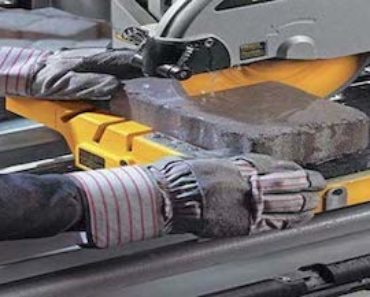Chainsaws are big and powerful machines, and one of the key factors when buying a chainsaw is its weight. Weight plays an important factor when choosing the perfect chainsaw for yourself, depending on the type of work you will be doing. So, how much does a chainsaw weigh?
A chainsaw typically weighs between 9 and 14 pounds. Although some heavier and more powerful gas-powered chainsaws could even weigh more than 18 pounds, many of the lighter electric chainsaws can be as little as 5 pounds.
This is just a glimpse of the total weight of the chainsaw, and the actual weight heavily varies depending on the type of chainsaw. Thus, we suggest you read below to know all about chainsaw weight.
Table of Contents
What Factors Affect The Chainsaw Weight?
There are many factors that can actually affect the weight of the chainsaw. So, before knowing about the weight of different types of chainsaws, we need to learn about all these factors.
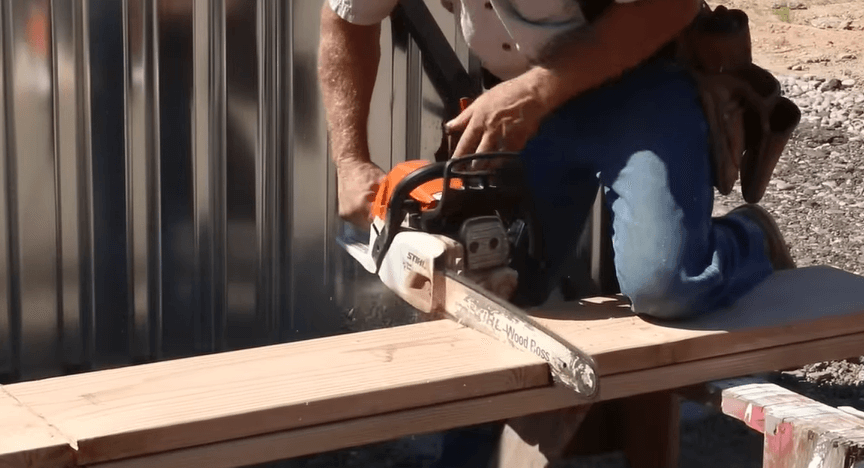
Power Source
The power supply is among the major elements affecting the chainsaw’s weight. Chainsaws come in gas, electric, and battery varieties. Each needs a particular set of materials and building requirements. A chainsaw fueled by gas will often weigh more than one driven by electricity, with battery-powered being the mid option.
Fuel capacity of a chainsaw fueled by gas would most probably range from seven to 44 ounces. Therefore, it is obvious how hefty gas-powered chainsaws are. Additionally, batteries can be rather heavy, but with chainsaws driven by electricity, the only weight is the weight of the power cord.
Length of bar and chain
With the same powerhead, several chainsaws are available with different bar lengths. The guide bar and chain may contribute a substantial amount of weight based on their size.
The length of chainsaw bars normally ranges from 12 to 36 inches. A 22-inch bar and associated chain weigh significantly more than a 16-inch bar since they are metal parts.
Chain and Bar Oil
Another weight contributing factor in chainsaw is chain and bar oil. The bar oil adds a significant amount of weight to the chainsaw. Also, non-gas-powered chainsaws also require some chain oil to work well, which adds to the weight as well.
There is bar oil in every chainsaw. Despite variations in capacity, reservoirs frequently hold at least 8 ounces. Bigger saws can weigh much more due to larger oil capacity.
Determining the weight of the oil is a bit complicated for its density and several other parameters. But roughly speaking, we can anticipate seeing a body weight of around 0.25 to 1.25 pounds.
How Much Does A Chainsaw Weigh?
Down below, we will discuss the weight of different types of chainsaws along with a few examples which will help you understand the discussion in more detail.
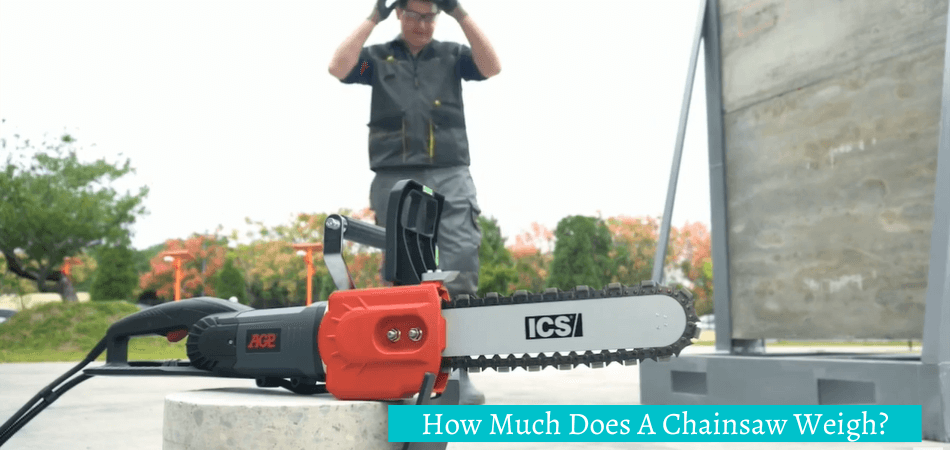
1. Battery-powered Chainsaws
The first type of chainsaw we will talk about is the battery-powered one. These are normally significantly lighter than their gas-powered equivalents and are usually pretty light themselves. Battery-powered chainsaws are in the middleweight class.
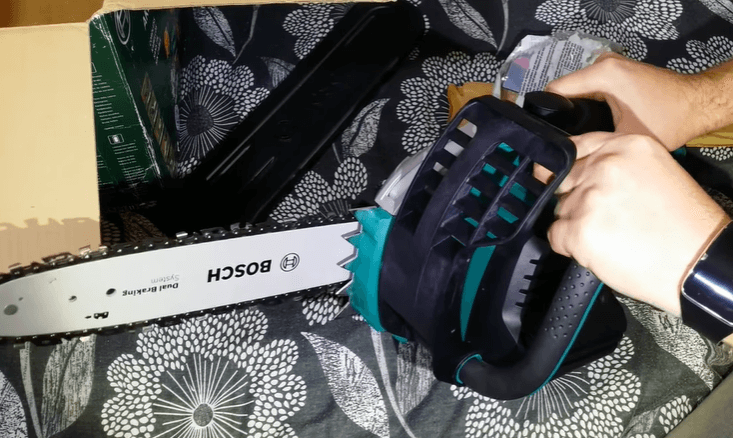
They seem to be a little heavier than electric chainsaws, and that’s owing to the batteries it comes with. Lithium batteries are rather dense while being lightweight for their size. Without the battery, battery saws weigh roughly 8 pounds.
A battery-powered 18-inch chainsaw typically weighs between 11 and 14 pounds. The battery is probably larger if you come across a battery-operated chainsaw that is heavier than usual.
| Model | Weight (Pounds) |
| Ego 56 Volt 5 Ah battery ( 18 inch bar) | 14.5 |
| Husqvarna 120i, 40 Volt 4 Ah battery (14 inch bar) | 11.9 |
| Makita XCU04Z 36 Volt 4 Ah battery (16 inch bar) | 11.2 |
| Ryobi 40 volt 4 Ah Battery (14-inch bar) | 11.5 |
| Greenworks 12-Inch 40V 2.0 Ah battery | 8.31 |
2. Manual / Pocket Chainsaws
An operator can cut through branches and medium-sized trees using a manual or pocket chainsaw, which has two large nylon handlebars and chainsaw blades up to 36 inches long.

Other applications for the pocket chainsaw include pruning branches higher in your tree by simply wrapping a rope around the limb, fastening the tool, and pulling back and forth on opposite sides with long ropes.
Among all other versions, the manual or pocket chainsaw is the lightest; it weighs less than 0.5-1 pounds on average. This is mostly due to its small, compact form. In addition, human labor, rather than any kind of fuel or another form of energy, is used.
| Model | Weight (Pounds) |
| Sportsman Industries Pocket Chainsaw 36 Inch | 0.31 |
| Nordic Pocket Saw Pocket Chainsaw – 25.6 inch | 0.29 pounds |
| YOKEPO Survival Pocket Chainsaw 24 inch | 0.44 |
| SUMPRI Pocket Chainsaw Survival Gear -36 Inch | 0.53 |
| Pocket Chainsaw with Paracord Handle – 36 inch | 0.35 |
3. Corded-electric Chainsaws
Generally, an electric chainsaw will be considered a featherweight. They are substantially lighter than the other powered chainsaws. They don’t require a large engine or batteries because they run on electricity.
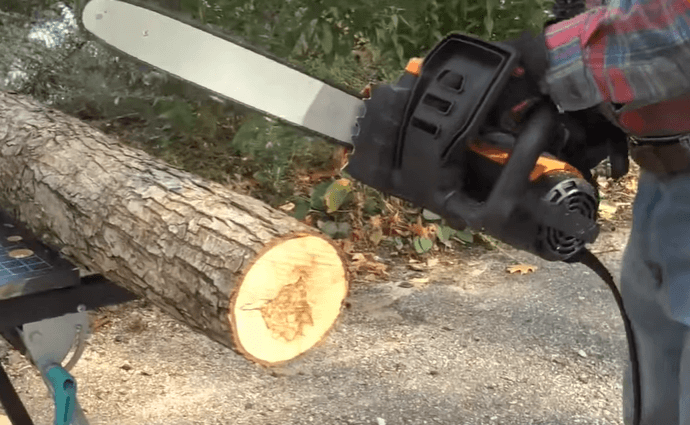
However, you will still have to apply chain oil to lube it, which will result in this chainsaw becoming slightly heavier. An electric start chainsaw typically weighs between 6 and 10 pounds.
This sort of chainsaw is simple to use and is perfect for little jobs such as pruning branches or chopping firewood.
| Model | Weight (Pounds) |
| Oregon CS1500 15 Amp – 18 inches | 12.6 |
| Remington RM1425 8 Amp 14-Inch | 6.25 |
| Stihl MSE 25 – 16-inch | 9.4 |
| Worx 15 Amp – 18 inch | 11.3 |
| Ryobi 13 Amp – 16 inch | 5.8 |
4. Pole Chainsaws
Pole chainsaws are the best option for easily pruning difficult-to-reach branches. Instead of using a ladder, pole chainsaws are excellent for maintaining yard shrubs and branches. This lowers the risk of being in a potentially hazardous position or falling from a height.
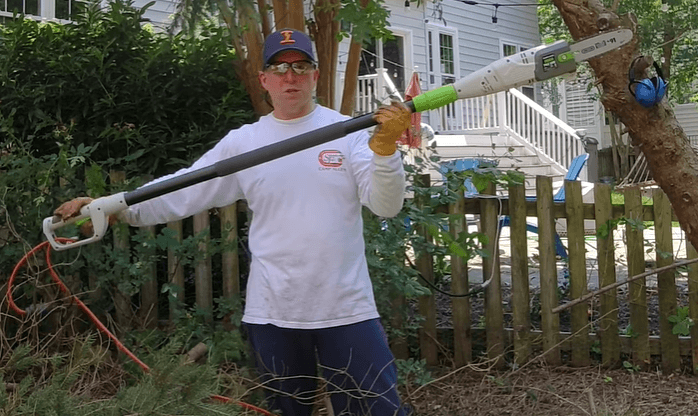
These saws are comparatively heavier, weighing roughly 20-25 pounds due to the increased pole weight and battery, and some are even gas-powered. You will also find lighter electric corded options weighing less than 15 pounds.
While this chainsaw does successfully chop down timber, it’s not large enough to totally replace a chainsaw.
| Model | Weight (Pounds) |
| Greenworks 40V 8-inch Cordless Pole Saw | 11 |
| WORX WG309, 8 Amp 10-inch Corded Electric Pole Saw | 10 |
| Sun Joe SWJ800E 8-Inch 6.5-Amp Telescoping Electric Pole Chain Saw | 7 |
| WORX WG349 20V Power Share 8″ Pole Saw | 8.8 |
| MAXTRA Pole Saw Gas Powered | 21 |
5. Gas-powered Chainsaws
Gas-powered chainsaws are the heaviest chainsaws available on the market. They are the heaviest of the bunch but are also said to be the strongest chainsaw. These tools will be lightweight as they won’t need fuel or oil.
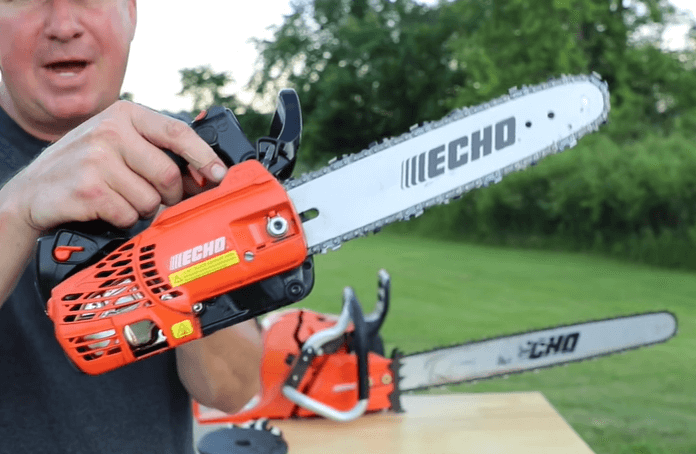
The weight will rise after gasoline and oil are added. The weight of these chainsaws is further increased due to the 2-stroke motor, which needs sturdy metal parts to manage the power of compression ignition.
Gas powered chainsaws are also one of the best chainsaws for limbing and gas powered or limbing chainsaw weighs over ten pounds without oil and gasoline. Small gas-powered chainsaws with 14–16-inch bars may weigh just under 10 pounds, while saws with 18–24–inch bars will likely weigh 12–14 pounds or more.
| Model | Powerhead Weight |
| STIHL MS 880 MAGNUM – 25 inch | 22.3 lbs |
| ECHO CS-310 – 14 Inch | 8.8 lbs |
| HUSQVARNA 460 Rancher – 24 Inch | 13.2 lbs |
| STIHL MS 170 – 16 Inch | 8.6 lbs |
| Husqvarna 3120XP – 46 inch | 22.9 lbs |
6. Pneumatic Chainsaws
These chainsaws are far more prevalent in industrial settings, particularly for horticulture activities, which are likely to call for a pneumatic chainsaw. In many circumstances, they are more powerful than chainsaws driven by gas.
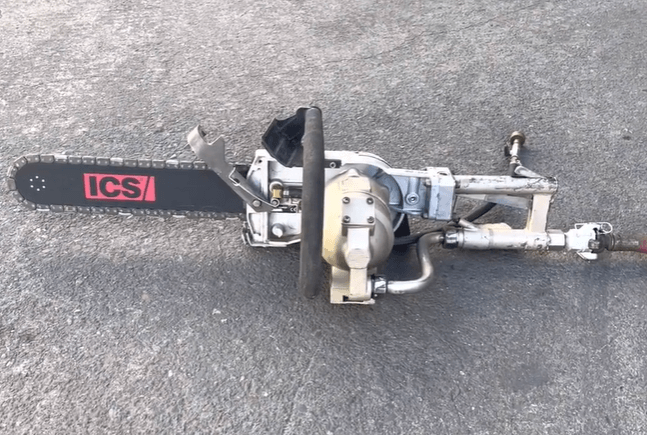
Pneumatic chainsaws come in a wide range of weights, ranging from 5.4 pounds to over 100 pounds, and are propelled by air pockets at tremendous pressure. They are helpful in construction because they can generate enough force to cut straight lines in metal and concrete.
| Model | Weight of powerhead (Pounds) |
| ICS 701A | 30.4 |
| CS UNITEC 4 HP – 50070040 | 40 |
| RED ROOSTER RRI-8560 | 16.76 |
| Spitznas – 510280010 | 18.74 |
Does Chainsaw Weight Affect The Cutting Performance?
Finding the light chainsaw can seem like the wisest course of action, but that might not always be. Therefore, even if it primarily relies on your type of job, weight does have an impact on the chainsaw’s performance.

You will need to select the chainsaw weight depending on the type of work you are going to do. Read below to know more.
For heavy works
Heavy-duty tasks in harvesting and forests need flawless cuts, which calls for heavier chainsaws. Gas-powered chainsaws are the greatest choice for this since they have the most weight. However, larger chainsaws need more oil and gasoline.
For Cutting branches and limbs
Now, you will need lightweight chainsaws, such as electric chainsaws, if you want to chop branches or limbs that can be readily done in restricted locations. Because they don’t have a hot, open engine, they are also safer than ones powered by gas. Additionally, because of their simplicity of use, they are suitable for DIY and home users.
For Hedges trimming
When searching for a chainsaw for tasks like chopping firewood, trimming hedges, and clearing away tree branches, you need to focus on portability—which battery-powered chainsaws may offer—is what you need to focus on. They are highly effective in isolated locations and have a lot of power. Additionally, they are a better option for injured employees.
For cutting low tree branches
If you wish to remove tree branches from long trees, you will need a lower-weight saw as you have to raise your arm high to remove it. The best option for this is to choose an electric-powered pole saw.
Are lighter weight chainsaws actually better?
Lighter chainsaws do come with a lot of advantages in the long run. However, it mostly depends on your preferences and the type of work you are using the chainsaw for. Read below to know more.
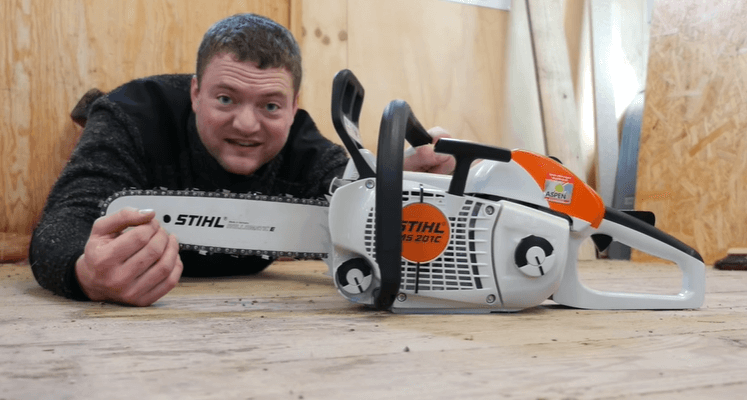
Useful for smaller work
Smaller diameter trees are simpler to cut down with lighter chainsaws because they are easier to handle at low angles. Cutting logs may also use a lighter chainsaw to chop a tree into workable logs once it has been felled. Cleaning up after trees that have suddenly collapsed on your property follows the same principles.
Easy to use
Additionally, compared to their overpowering counterparts, lightweight chainsaws are safer, better compact, more adaptable, quieter, cheaper, and a better starting point for clearing bush.
Beginner Friendly
They are also easier for beginners to operate because using stronger and heavier saws takes training and expertise. As a result, there is a considerable likelihood that beginners will be injured by heavier chainsaws.
Frequently Asked Question
Down below, we will discuss a few of the faqs regarding our today’s guide on the weight of chainsaws. These questions will further clear any more confusion you may have.
What Is the Powerhead Weight of a Chainsaw?
Once you take the chain and guide bar along with any fuel or oil off the chainsaw, the weight that remains is the powerhead weight. You might think of this as the engine’s total weight plus the accessories that encircle it, therefore the term power-head.
What Is the Dry Weight of a Chainsaw?
In a nutshell, the chainsaw’s “dry weight” is the weight of the tool without any fuel or bar oil. Producers frequently refer to the chainsaw’s dry weight while describing its specifications. On average, the dry weight of a chainsaw is between 10-16 pounds depending on the type, guide bar, and model of the chainsaw.
What is the heaviest chainsaw?
There are many different types of chainsaws available in the market from a variety of manufacturers. But generally compared, gas-powered chainsaws are the heaviest among all other types of chainsaws. They are also the most powerful, and most of the models come with heavy engines, making them suitable for professional usage.
What Is Considered the Total Weight of a Chainsaw?
Despite the fact that manufacturers frequently include the dry weight or the powerhead weight when listing their devices. However, this is not the chainsaw’s complete weight. The weight of the gasoline, oil, fuel tank, and all additional equipment, such as the weight of the guide bar and chain, all make up the total weight.
Conclusion
So, if you are thinking of buying a chainsaw, then weight plays a key factor. You should carefully look at the weight of different types of chainsaws to find the perfect one. Thus, to make your work easier today, we discussed different chainsaw weight prospects in this guide.
Now, it depends on you to see which type of chainsaw you actually need. A decent chainsaw shouldn’t be too heavy since if it is, you will tire more quickly, and chopping with the chainsaw won’t be as efficient.
However, a heavier gas chainsaw is preferable to a small electric saw for chopping large amounts of wood. Then again, power is more important than weight for shedding tree limbs, so an electric saw is much better.

